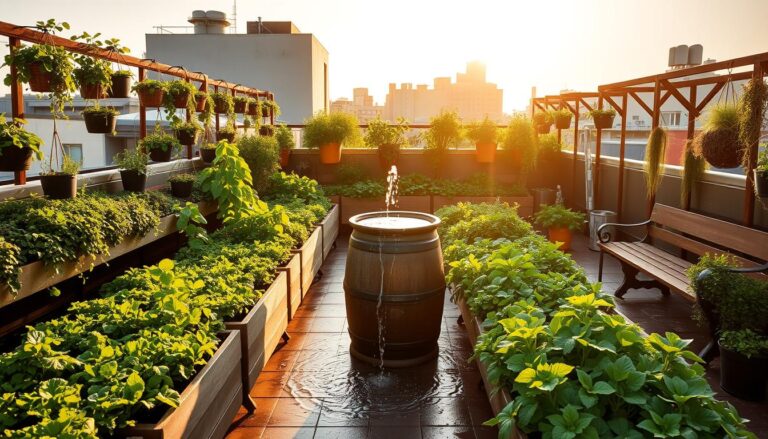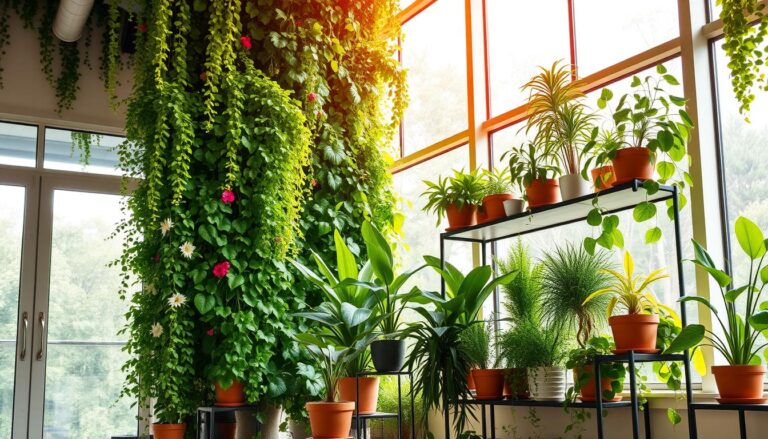Did you know that 1 in 3 bites of food we eat come from pollinators like bees and butterflies? By learning how to attract these creatures to your garden, you can help your garden thrive. This supports garden wildlife and helps pollinator-friendly plants grow.
Creating a home for these pollinators is simple. Start by making a few changes to your garden. With the right plants, water, and shelter, you can attract many pollinators. This will make your garden healthy and vibrant.
By following these easy steps, you can make your garden a welcoming place for bees, butterflies, and other beneficial insects. This not only helps garden wildlife but also supports the environment’s health.
Key Takeaways
- Learn how to attract butterflies and bees to your garden with simple, effective steps
- Create a pollinator-friendly garden that supports local garden wildlife
- Choose the right pollinator-friendly plants to attract a variety of bees and butterflies
- Provide a source of water and shelter for pollinators to thrive
- Support the local ecosystem and contribute to a healthy environment by creating a haven for pollinators
Understanding Why Your Garden Needs Pollinators
Pollinators like bees and butterflies are key to our ecosystem’s health. By attracting beneficial insects to our gardens, we help the local food chain and the environment. Over 75% of the world’s flowers need pollinators to reproduce. So, it’s vital to make our gardens bee-friendly and habitat for butterflies.
Some key benefits of pollinators include:
- Pollination of plants, which is essential for food production
- Contribution to ecosystem services, such as water purification and air quality improvement
- Support for biodiversity, by helping to maintain the balance of nature
By using bee-friendly garden tips and creating a habitat for butterflies, we support these vital insects. We can do this by planting nectar-rich flowers, providing food, and creating diverse habitats. This meets the needs of different pollinators.
Pollinators face many threats, like habitat loss, pesticide use, and climate change. By making our gardens pollinator-friendly, we help fight these threats. This supports the local pollinator population.
Essential Features of a Pollinator-Friendly Garden
Creating a pollinator-friendly garden starts with the right plants. Pollinator-friendly plants like native flowers, herbs, and shrubs feed and shelter bees and butterflies. It’s important to pick plants that bloom at different times to keep a steady supply of nectar and pollen.
Native plants are key in a pollinator-friendly garden. They need less care and are stronger. Some good native plants include:
- Butterfly milkweed
- Bee balm
- Lavender
- Coneflower
Creating a welcoming space is also important. This means adding water sources, resting spots, and shelters. These features attract a variety of pollinators, like bees, butterflies, and hummingbirds.
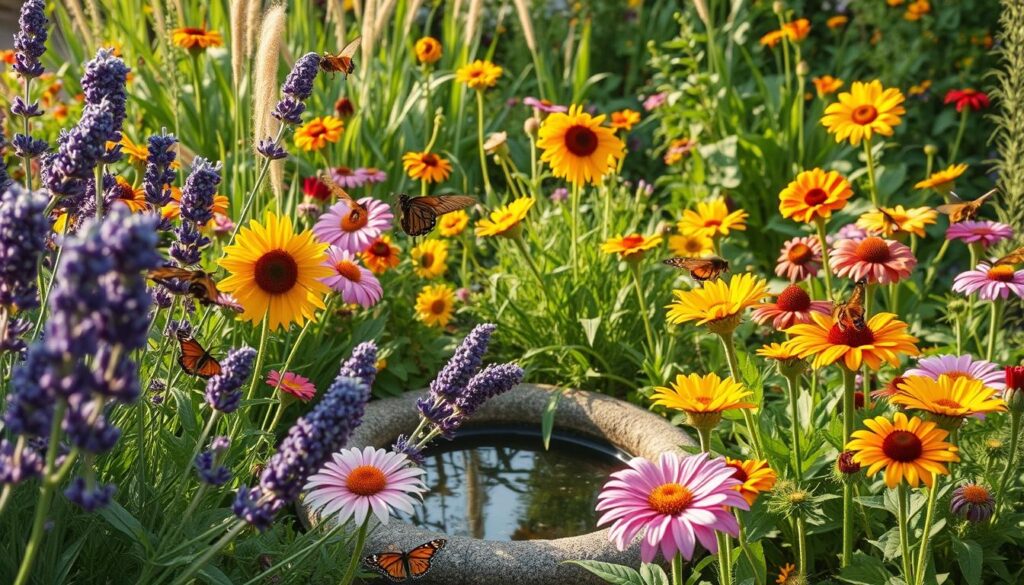
By following these tips and choosing the right pollinator-friendly plants, you can make a garden that helps local pollinators. It will also make your outdoor space more beautiful.
| Plant Type | Benefits for Pollinators |
|---|---|
| Native Flowers | Provide nectar and pollen, require less maintenance |
| Herbs | Offer a source of food and shelter, attract a variety of pollinators |
| Shrubs | Provide shelter and habitat for pollinators, offer a source of food |
How to Attract Butterflies and Bees to Your Garden
Attracting pollinators to your garden is key for plant health and the environment. Gardening for bees and butterflies is fun and rewarding. To attract them, create a welcoming space that meets their needs.
Creating Safe Water Sources
A safe water source is vital for pollinators. Bees and butterflies drink water and cool their bodies. You can make a safe water spot with a birdbath or small pond. Add rocks or twigs for perching.
Building Natural Shelters
Natural shelters are important for pollinators. They need a place to hide from wind, rain, and predators. Plant native plants like shrubs and trees to create a habitat.
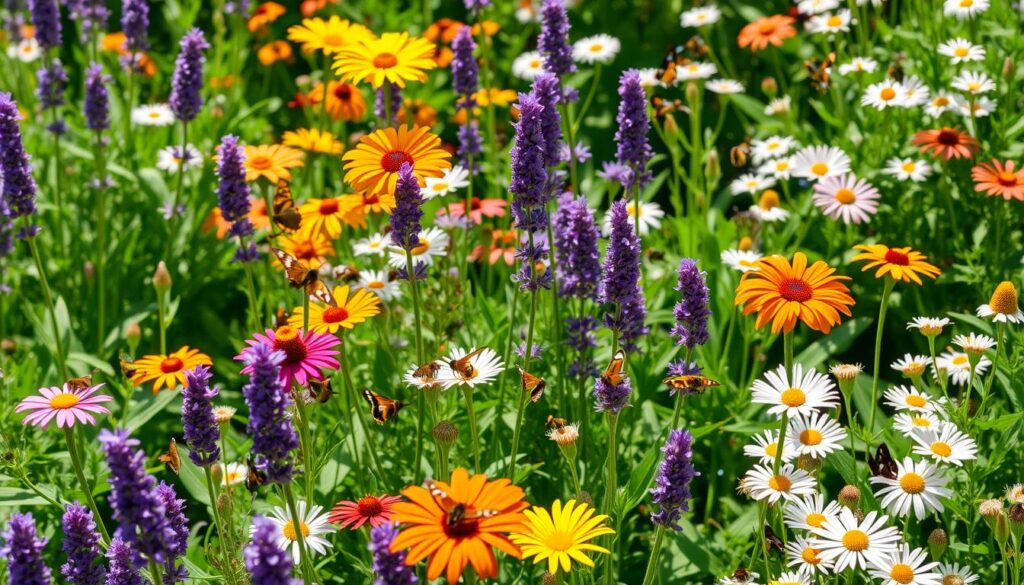
Providing Sunny Resting Spots
Sunny spots are key for pollinators. Bees and butterflies need a warm, sunny place to rest. Plant sun-facing flowers with flat surfaces for landing.
Follow these tips to make your garden a haven for bees and butterflies. Gardening for them helps the local pollinator population. It’s about creating a balanced ecosystem for both pollinators and plants.
Best Plants for Attracting Pollinators
To make your garden a haven for pollinators, pick the right plants. Pollinator-friendly plants are key, as they offer food and shelter for bees, butterflies, and more. Look for native flowers, herbs that bees love, and flowers that butterflies adore.
Native flowers like Penstemon, Coreopsis, and Rudbeckia are excellent choices. They’re not just pretty; they also draw in many pollinators. For instance, Rudbeckia is a hit with bees and butterflies. Coreopsis is perfect for attracting butterflies and hummingbirds.
Herbs such as Agastache and Monarda are also great picks. Agastache is a favorite of hummingbirds, while Monarda draws bees and butterflies. Choose a mix of plants that bloom at different times to keep food flowing for pollinators.
Here are some more plants that are perfect for attracting pollinators:
- Echinacea (Coneflower)
- Hardy Fuchsia
- Asters
- Yarrow
- Helenium
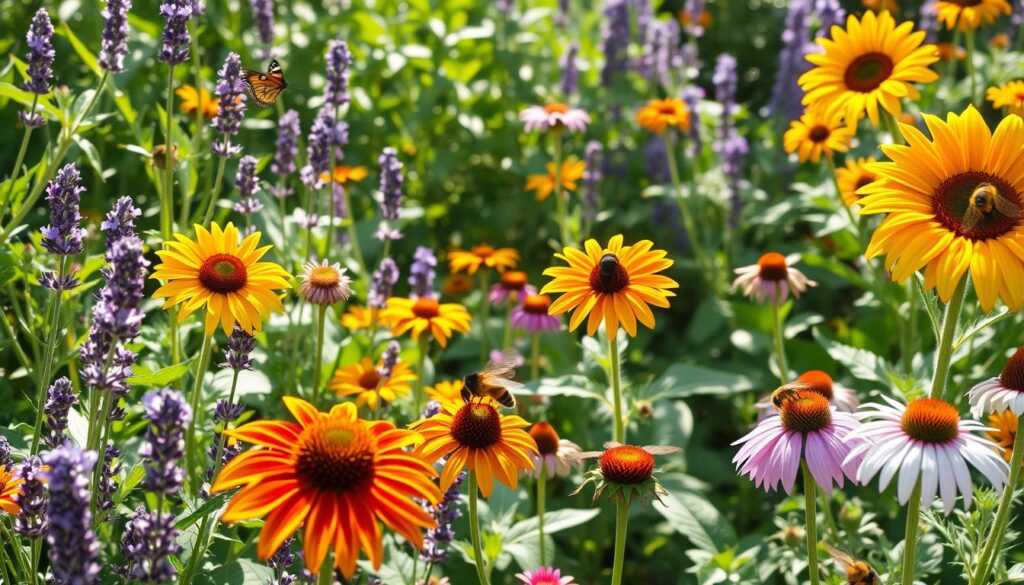
By adding these plants to your garden, you’ll create a haven for wildlife and support your local ecosystem. Plant at least 3×3 feet of each species to attract pollinators and keep food flowing all season.
| Plant | Height | Width |
|---|---|---|
| Penstemon | Up to 3 feet | Up to 2 feet |
| Coreopsis | 18-24 inches | 18-24 inches |
| Rudbeckia | 24-36 inches | 18-24 inches |
Garden Design Strategies for Maximum Pollinator Appeal
To attract butterflies and beneficial insects, design your garden carefully. Use a mix of plants, water sources, and sunny spots. This will make your garden a welcoming place for these insects.
Think about your garden’s layout and plant variety. Include annuals, perennials, and shrubs. This ensures pollinators have food all season, from spring to fall.
Bees and butterflies like simple flowers for easy pollen access. They’re drawn to different colors. Bees like blue, purple, and yellow, while butterflies prefer red, yellow, orange, pink, and purple.
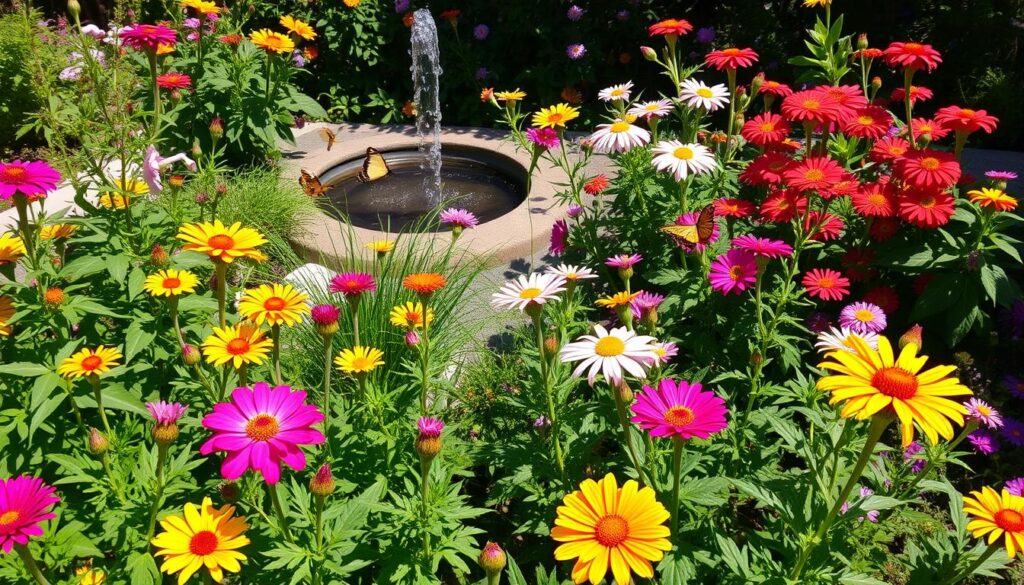
- Group plants together, not scatter them
- Use host plants for butterfly larvae
- Provide water sources like shallow dishes or birdbaths
- Include nesting sites like bare soil or dead wood
By following these tips, your garden will be beautiful and welcoming to pollinators. This helps these important insects and the ecosystem thrive.
| Plant | Height | Width | Zones |
|---|---|---|---|
| Blue Diamond Delphinium | 16-24″ | 10-12″ | 5-10 |
| Lantana | 2-6′ | 3-10′ | 7-11 |
| Daisy | 18-24″ | 18-24″ | 4-9 |
Maintaining Your Pollinator Paradise Year-Round
To keep your garden a haven for pollinators, it’s essential to maintain it throughout the year. Adapt your gardening for bees and butterflies to the changing seasons. This ensures you’re always attracting pollinators.
In the spring, focus on planting a diverse range of flowers. These should bloom from spring through fall, supporting pollinators year-round. Native flowers are great for creating a habitat for local pollinators.
Spring Care Tips
- Plant native flowers that bloom in the spring to provide an early source of nectar and pollen.
- Leave areas of dirt clear from debris and leaves for burrowing bees.
- Maintain leaf litter for ground-nesting bees to build their homes.
Summer Maintenance Guide
In the summer, ensure your garden remains welcoming for pollinators. Provide sunny spots and access to water. A mix of shady and sunny areas, along with a bird bath, attracts a variety of pollinators.
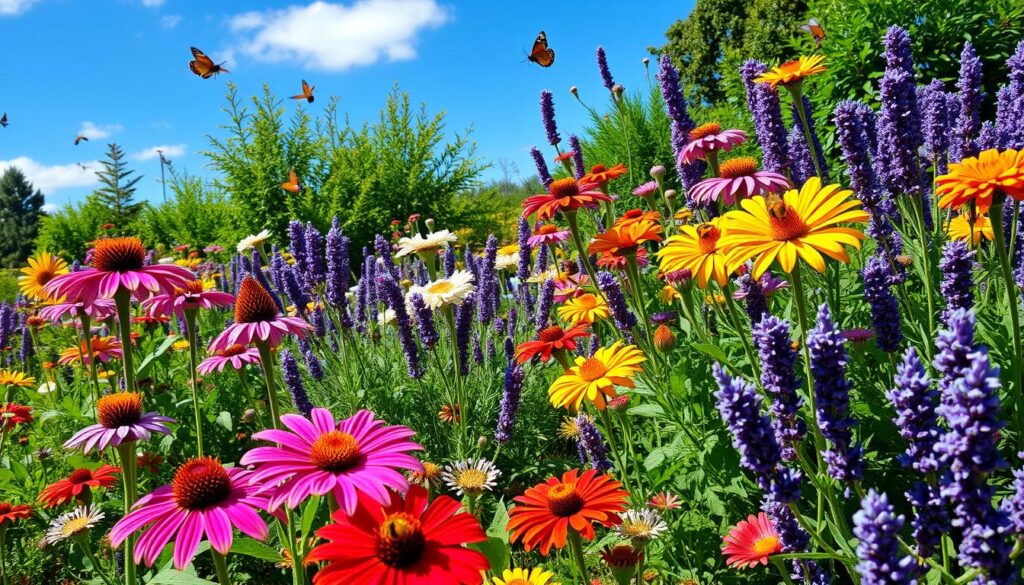
Fall and Winter Protection
In the fall and winter, protect your garden from harsh weather. Maintain its attractiveness to pollinators. Plant perennials that require less maintenance and can survive on average rainfall, returning year after year.
| Season | Gardening Tips |
|---|---|
| Spring | Plant native flowers, leave areas for burrowing bees |
| Summer | Provide sunny spots, access to water, and maintain leaf litter |
| Fall and Winter | Protect the garden, plant perennials for low maintenance |
Common Mistakes to Avoid When Creating a Pollinator Garden
Creating a pollinator-friendly garden is important. But, there are mistakes to avoid. Using too many pesticides is a big error. It harms pollinator-friendly plants and the pollinators. Instead, use natural methods like sticky traps and pheromone traps.
Another mistake is not having enough variety in plants. Planting three to five types of pollinator-friendly plants together helps bees and other pollinators. Good plants include White Coneflower, Garden Sage, and Native Bee Balm.
Here are some common mistakes to avoid:
- Using synthetic pesticides
- Lack of diversity in plant choice
- Not providing water sources
- Not creating resting spots for pollinators
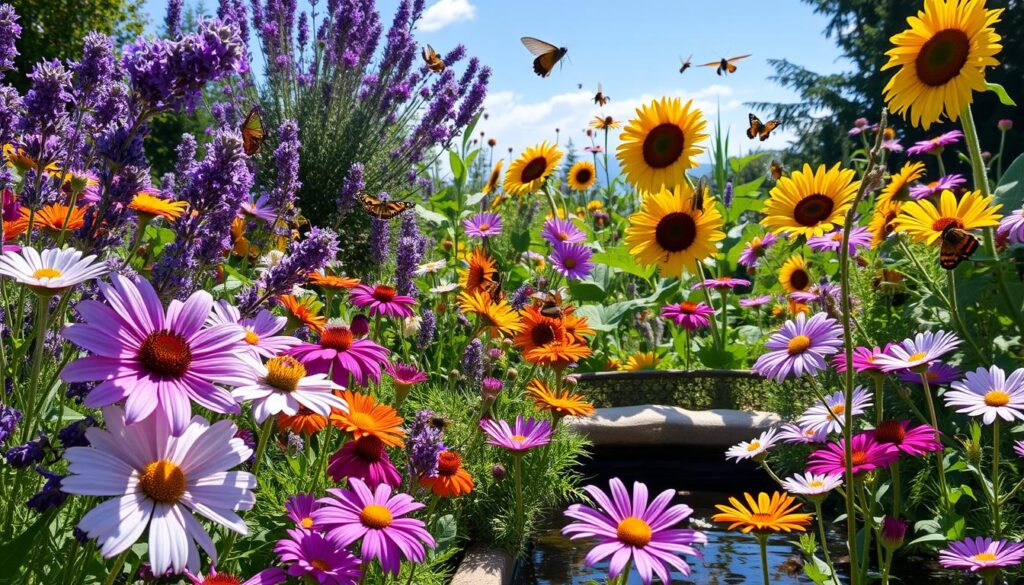
Avoiding these mistakes helps attract more garden wildlife. It also supports the local ecosystem. Make sure to provide water, create resting spots, and choose a variety of pollinator-friendly plants for a thriving garden.
| Plant | Benefits |
|---|---|
| White Coneflower | Attracts bees and butterflies |
| Garden Sage | Provides nectar for pollinators |
| Native Bee Balm | Supports native bee populations |
Natural Pest Control Methods That Won’t Harm Pollinators
Keeping a bee-friendly garden means using natural pest control. It’s key to attract beneficial insects for a healthy garden. Companion planting is a great way to do this. It pairs plants to keep pests away and draw in good bugs.
Native plants can boost native insect numbers by up to 60%. Row covers are also helpful. They keep pests out but let light and water in. Plants like Shasta daisies and Lupines can lure pests away from other plants.
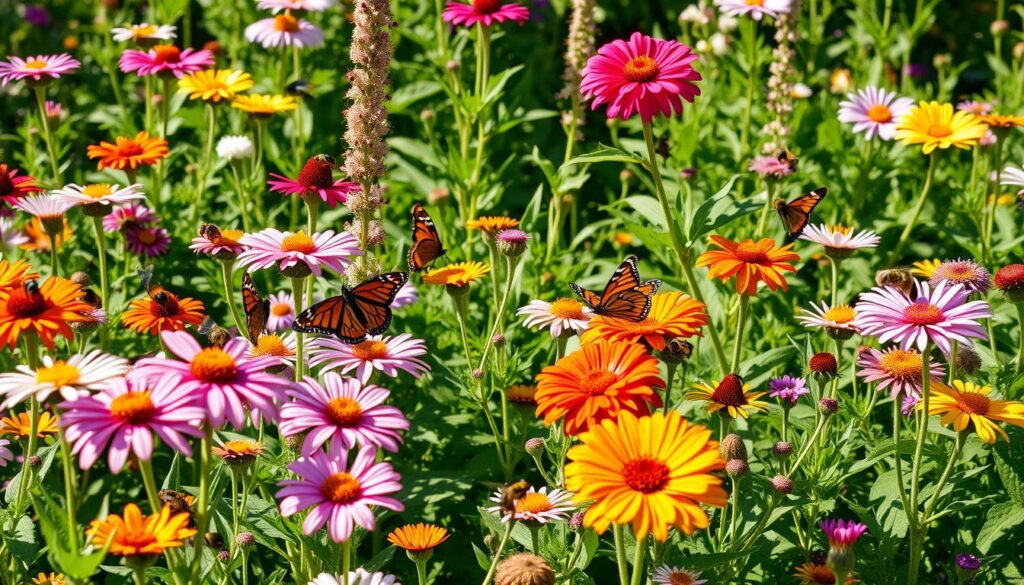
Using natural sprays like neem oil or essential oils is another good option. Apply them every 7-14 days to prevent pests. For outbreaks, spray twice a week. These sprays are safe for the environment and good for your garden.
Conclusion: Creating Your Thriving Pollinator Haven
Turning your garden into a haven for butterflies and bees is rewarding. It helps your local ecosystem and the global pollinators. By using native plants, adding water sources and shelter, and avoiding harmful chemicals, you create a lively, pollinator-friendly oasis.
Every small action to help pollinators in your garden is important. Enjoy watching the butterflies and bees in your garden. Feel proud of your role in supporting these essential creatures.
With your new knowledge and commitment, you can attract and maintain a healthy population of pollinators in your backyard. Get ready to see the buzzing and fluttering life you’ve helped create!

